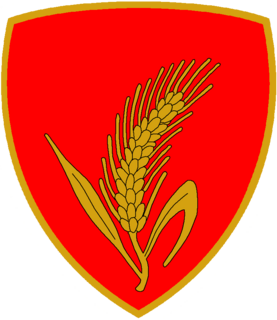The Southwestern Front was a front of the Red Army during the Second World War, formed thrice.

Semyon Ilyich Bogdanov was a Soviet Marshal of tank forces, and twice Hero of the Soviet Union.
The Gyorshadtest was the most modern and best-equipped mechanized unit of the Royal Hungarian Army at the beginning of World War II. However, the "Rapid Corps" name was something of a misnomer as it was only "mechanized" compared to other Hungarian units. The corps was not particularly mechanized when compared to similar units fielded by countries like Germany or the Soviet Union.
The 16th Army was a Soviet field army active from 1940 to 1945.

The Mechanized Brigade "Pinerolo" is a mechanized infantry brigade of the Italian Army, based in the southern region of Apulia. Carrying the name of the Piedmontese city of Pinerolo the brigade's coat of arms was modeled after the city's coat of arms. The brigade is part of the Division "Acqui".

The 131st Armoured Division Centauro was an armoured division of the Italian Army during World War II. It was formed in February 1939, by upgrading the 1st Armoured Brigade. It took part in operations in Albania, Greece and Yugoslavia before returning to Italy. Sent to North Africa in August 1942, it surrendered in Tunisia on 13 May 1943.
The 1st Armored Brigade is an Armored formation of People's Liberation Army of the People's Republic of China. The brigade now serves as the armored element under the 65th Army in the Beijing Military Region.
The 15th Rifle Division was a military formation of the Red Army formed by renaming the Red Army's Inza Revolutionary Division on 30 April 1919. The division was active during the Russian Civil War and World War II.
The 12th Guards Uman Orders of Lenin Red Banner and Suvorov Tank Division was a tank division of the Soviet Ground Forces. It drew its history from the World War II 16th Tank Corps. It was redesignated successively as 12th Guards Tank Corps (1943) and 12th Guards Tank Division (1946).

The Mechanized Brigade "Legnano" was a mechanized brigade of the Italian Army. Its core units were mechanized infantry battalions. The brigade's headquarters was in the city of Bergamo in Lombardy. The name of the brigade commemorates the Lombard League victory in the Battle of Legnano in 1176 and its coat of arms depicts the Monument to the Warrior of Legnano in the centre of Legnano.

The Motorized Brigade "Cremona" was an infantry brigade of the Italian Army. The brigade's headquarters was in the city of Turin. The brigade carried on the name and traditions of the 44th Infantry Division "Cremona".
The order of battle of the Spanish Army in 1989 is given below.
The 79th Motor Rifle Division was a motorized infantry division of the Soviet Army. It was converted from the 79th Rifle Division in 1957 and inherited the honorific "Sakhalin". The division was awarded the Order of the Red Banner. The 79th Rifle Division fought in the Invasion of South Sakhalin in 1945 and was based at Leonidovo for most of its career.
The 14th Mechanized Corps was a mechanized corps of the Red Army. Formed in March 1941 and stationed in western Belarus, the corps was destroyed in the Battle of Białystok–Minsk in June of the same year.
The 11th Mechanized Corps was a mechanized corps of the Red Army, formed twice. The corps was first formed as one of the original two Red Army mechanized corps from the 11th Rifle Division in Leningrad. In 1934 it was transferred to the Transbaikal Military District and in 1938 became the 20th Tank Corps. The corps was reformed in March 1941 in western Belarus. After the German invasion of the Soviet Union, the understrength corps was destroyed in the Battle of Białystok–Minsk.
The 13th Mechanized Corps was a mechanized corps of the Red Army, formed in March 1941. Stationed in the Białystok salient, the corps was destroyed during the Battle of Białystok–Minsk.
The 1st Tank Division was a Division sized unit of the Red Army that existed from 1940–42. It was later reformed, from a separate formation, with a different lineage. Within the Soviet Ground Forces it existed as a second line ready division from 1945–2008, at Kaliningrad in the Baltic Military District.
With the 1975 reforms the Italian Army abolished the regimental level and replaced it with brigades made up of multiple arms. During the reform the army disbanded 48 regimental commands and reduced its force by 87 battalions. A further ten regimental commands were used to raise ten new brigade commands. Ten training centers, which for traditional reasons had carried the names of regiments, were also disbanded. The reduction in units also allowed to mechanize most of the remaining units in Northern Italy and Italy's defense strategy changed from a hold-at-all-costs territorial defense to one of mobile warfare.
The 60th Mountain Rifle Division was formed as a specialized infantry division of the Red Army in the spring of 1941, based on the 60th "Caucasian" Rifle Division which traced its origins back to just after the Russian Civil War. At the time of the German invasion on June 22 it was located in the foothills of the Carpathian Mountains near the border with Hungary as part of the 17th Rifle Corps of 12th Army in the Kiev Special Military District. While the division was not attacked by the main German forces in the first days, its almost total lack of trucks and shortage of horses made it difficult to retreat to the east. It was soon transferred with 17th Corps to the new 18th Army in Southern Front, but returned to 12th Army in mid-July. It fell back through western Ukraine under that headquarters into August when it found itself encircled in the Uman pocket where all but remnants of the division were destroyed. The 60th Mountain was finally officially disbanded on September 19.




